A Systematic Review on FAP Efficacy in Depression Treatment
VerifiedAdded on 2023/01/19
|11
|1955
|27
Report
AI Summary
This report presents a systematic review investigating the efficacy of Functional Analytic Psychotherapy (FAP) in treating depression. The review encompasses studies published between 2013 and 2018, focusing on peer-reviewed articles from databases such as Google Scholar, Medline, PubMed, and PsycINFO. The report examines the methodology and findings of various studies, including those using ANOVA, t-tests, and correlations, to determine the effectiveness of FAP. Key findings highlight the potential of FAP in reducing depressive symptoms and improving interpersonal relating, with some studies comparing it to other therapeutic approaches like supportive listening. The report also addresses the implementation of FAP in different settings, such as nursing homes, and discusses the importance of considering in-session and out-of-session client behavior. The review concludes by synthesizing the evidence to provide an overview of FAP's efficacy and areas for further research.
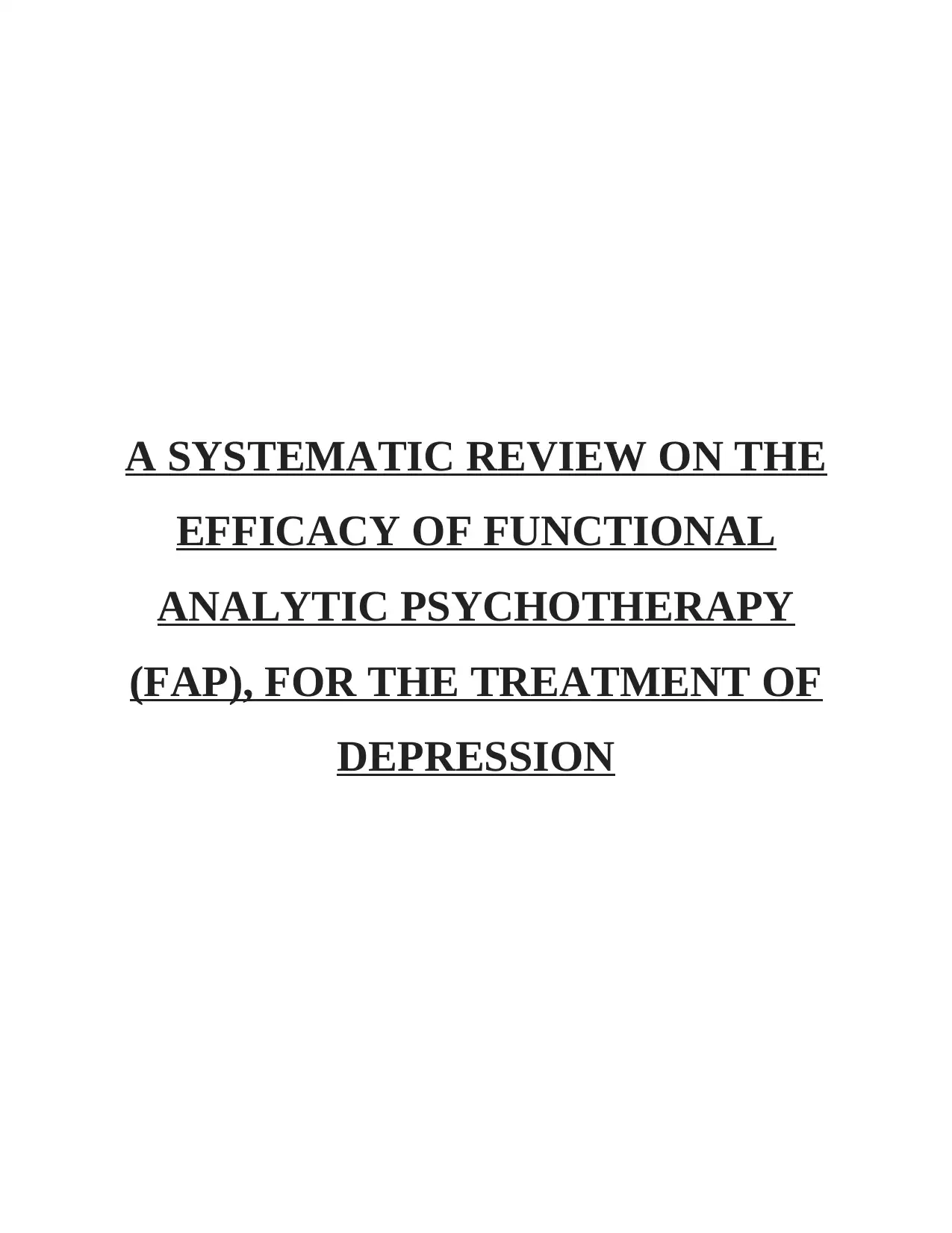
A SYSTEMATIC REVIEW ON THE
EFFICACY OF FUNCTIONAL
ANALYTIC PSYCHOTHERAPY
(FAP), FOR THE TREATMENT OF
DEPRESSION
EFFICACY OF FUNCTIONAL
ANALYTIC PSYCHOTHERAPY
(FAP), FOR THE TREATMENT OF
DEPRESSION
Paraphrase This Document
Need a fresh take? Get an instant paraphrase of this document with our AI Paraphraser
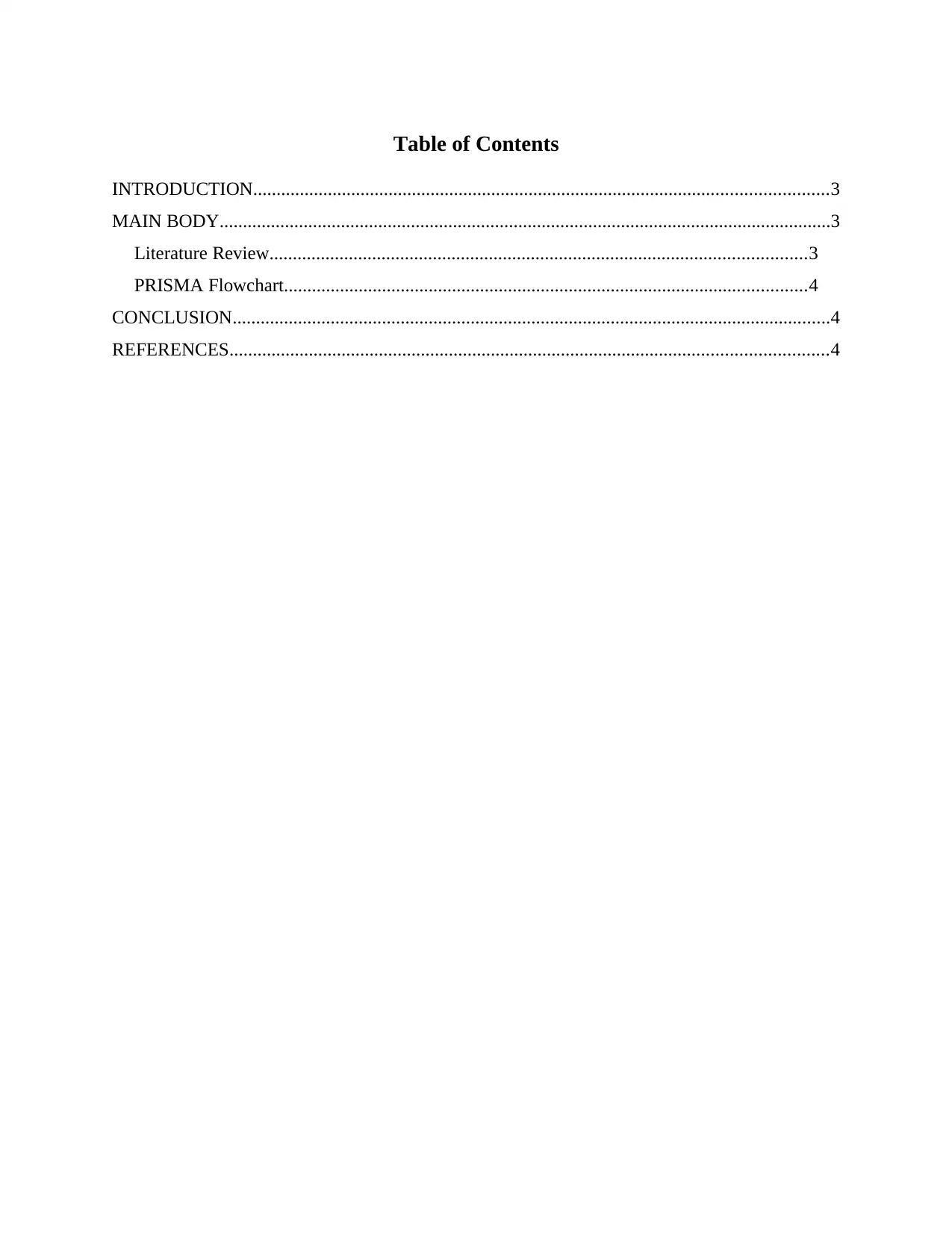
Table of Contents
INTRODUCTION...........................................................................................................................3
MAIN BODY...................................................................................................................................3
Literature Review...................................................................................................................3
PRISMA Flowchart................................................................................................................4
CONCLUSION................................................................................................................................4
REFERENCES................................................................................................................................4
INTRODUCTION...........................................................................................................................3
MAIN BODY...................................................................................................................................3
Literature Review...................................................................................................................3
PRISMA Flowchart................................................................................................................4
CONCLUSION................................................................................................................................4
REFERENCES................................................................................................................................4
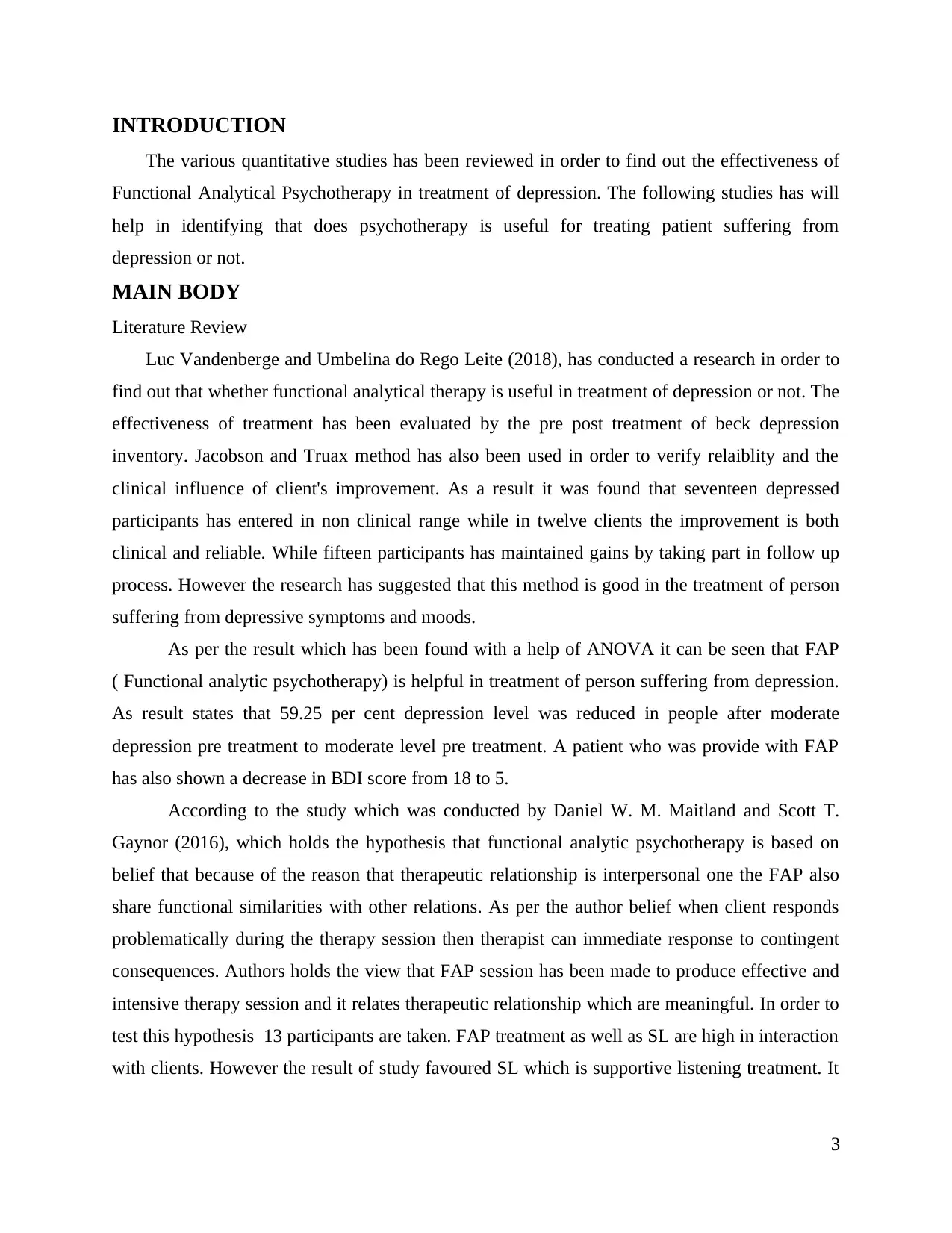
INTRODUCTION
The various quantitative studies has been reviewed in order to find out the effectiveness of
Functional Analytical Psychotherapy in treatment of depression. The following studies has will
help in identifying that does psychotherapy is useful for treating patient suffering from
depression or not.
MAIN BODY
Literature Review
Luc Vandenberge and Umbelina do Rego Leite (2018), has conducted a research in order to
find out that whether functional analytical therapy is useful in treatment of depression or not. The
effectiveness of treatment has been evaluated by the pre post treatment of beck depression
inventory. Jacobson and Truax method has also been used in order to verify relaiblity and the
clinical influence of client's improvement. As a result it was found that seventeen depressed
participants has entered in non clinical range while in twelve clients the improvement is both
clinical and reliable. While fifteen participants has maintained gains by taking part in follow up
process. However the research has suggested that this method is good in the treatment of person
suffering from depressive symptoms and moods.
As per the result which has been found with a help of ANOVA it can be seen that FAP
( Functional analytic psychotherapy) is helpful in treatment of person suffering from depression.
As result states that 59.25 per cent depression level was reduced in people after moderate
depression pre treatment to moderate level pre treatment. A patient who was provide with FAP
has also shown a decrease in BDI score from 18 to 5.
According to the study which was conducted by Daniel W. M. Maitland and Scott T.
Gaynor (2016), which holds the hypothesis that functional analytic psychotherapy is based on
belief that because of the reason that therapeutic relationship is interpersonal one the FAP also
share functional similarities with other relations. As per the author belief when client responds
problematically during the therapy session then therapist can immediate response to contingent
consequences. Authors holds the view that FAP session has been made to produce effective and
intensive therapy session and it relates therapeutic relationship which are meaningful. In order to
test this hypothesis 13 participants are taken. FAP treatment as well as SL are high in interaction
with clients. However the result of study favoured SL which is supportive listening treatment. It
3
The various quantitative studies has been reviewed in order to find out the effectiveness of
Functional Analytical Psychotherapy in treatment of depression. The following studies has will
help in identifying that does psychotherapy is useful for treating patient suffering from
depression or not.
MAIN BODY
Literature Review
Luc Vandenberge and Umbelina do Rego Leite (2018), has conducted a research in order to
find out that whether functional analytical therapy is useful in treatment of depression or not. The
effectiveness of treatment has been evaluated by the pre post treatment of beck depression
inventory. Jacobson and Truax method has also been used in order to verify relaiblity and the
clinical influence of client's improvement. As a result it was found that seventeen depressed
participants has entered in non clinical range while in twelve clients the improvement is both
clinical and reliable. While fifteen participants has maintained gains by taking part in follow up
process. However the research has suggested that this method is good in the treatment of person
suffering from depressive symptoms and moods.
As per the result which has been found with a help of ANOVA it can be seen that FAP
( Functional analytic psychotherapy) is helpful in treatment of person suffering from depression.
As result states that 59.25 per cent depression level was reduced in people after moderate
depression pre treatment to moderate level pre treatment. A patient who was provide with FAP
has also shown a decrease in BDI score from 18 to 5.
According to the study which was conducted by Daniel W. M. Maitland and Scott T.
Gaynor (2016), which holds the hypothesis that functional analytic psychotherapy is based on
belief that because of the reason that therapeutic relationship is interpersonal one the FAP also
share functional similarities with other relations. As per the author belief when client responds
problematically during the therapy session then therapist can immediate response to contingent
consequences. Authors holds the view that FAP session has been made to produce effective and
intensive therapy session and it relates therapeutic relationship which are meaningful. In order to
test this hypothesis 13 participants are taken. FAP treatment as well as SL are high in interaction
with clients. However the result of study favoured SL which is supportive listening treatment. It
3
⊘ This is a preview!⊘
Do you want full access?
Subscribe today to unlock all pages.

Trusted by 1+ million students worldwide
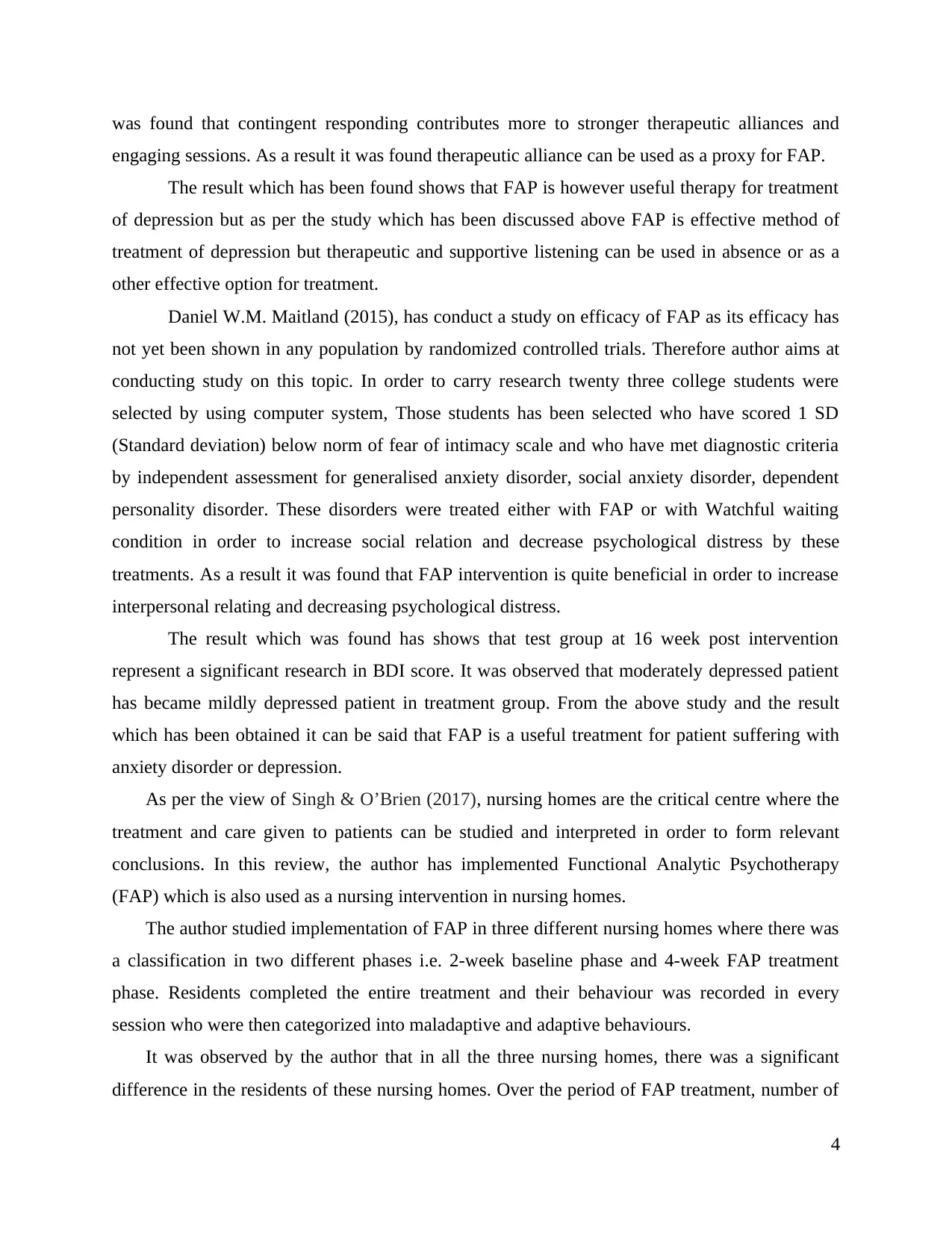
was found that contingent responding contributes more to stronger therapeutic alliances and
engaging sessions. As a result it was found therapeutic alliance can be used as a proxy for FAP.
The result which has been found shows that FAP is however useful therapy for treatment
of depression but as per the study which has been discussed above FAP is effective method of
treatment of depression but therapeutic and supportive listening can be used in absence or as a
other effective option for treatment.
Daniel W.M. Maitland (2015), has conduct a study on efficacy of FAP as its efficacy has
not yet been shown in any population by randomized controlled trials. Therefore author aims at
conducting study on this topic. In order to carry research twenty three college students were
selected by using computer system, Those students has been selected who have scored 1 SD
(Standard deviation) below norm of fear of intimacy scale and who have met diagnostic criteria
by independent assessment for generalised anxiety disorder, social anxiety disorder, dependent
personality disorder. These disorders were treated either with FAP or with Watchful waiting
condition in order to increase social relation and decrease psychological distress by these
treatments. As a result it was found that FAP intervention is quite beneficial in order to increase
interpersonal relating and decreasing psychological distress.
The result which was found has shows that test group at 16 week post intervention
represent a significant research in BDI score. It was observed that moderately depressed patient
has became mildly depressed patient in treatment group. From the above study and the result
which has been obtained it can be said that FAP is a useful treatment for patient suffering with
anxiety disorder or depression.
As per the view of Singh & O’Brien (2017), nursing homes are the critical centre where the
treatment and care given to patients can be studied and interpreted in order to form relevant
conclusions. In this review, the author has implemented Functional Analytic Psychotherapy
(FAP) which is also used as a nursing intervention in nursing homes.
The author studied implementation of FAP in three different nursing homes where there was
a classification in two different phases i.e. 2-week baseline phase and 4-week FAP treatment
phase. Residents completed the entire treatment and their behaviour was recorded in every
session who were then categorized into maladaptive and adaptive behaviours.
It was observed by the author that in all the three nursing homes, there was a significant
difference in the residents of these nursing homes. Over the period of FAP treatment, number of
4
engaging sessions. As a result it was found therapeutic alliance can be used as a proxy for FAP.
The result which has been found shows that FAP is however useful therapy for treatment
of depression but as per the study which has been discussed above FAP is effective method of
treatment of depression but therapeutic and supportive listening can be used in absence or as a
other effective option for treatment.
Daniel W.M. Maitland (2015), has conduct a study on efficacy of FAP as its efficacy has
not yet been shown in any population by randomized controlled trials. Therefore author aims at
conducting study on this topic. In order to carry research twenty three college students were
selected by using computer system, Those students has been selected who have scored 1 SD
(Standard deviation) below norm of fear of intimacy scale and who have met diagnostic criteria
by independent assessment for generalised anxiety disorder, social anxiety disorder, dependent
personality disorder. These disorders were treated either with FAP or with Watchful waiting
condition in order to increase social relation and decrease psychological distress by these
treatments. As a result it was found that FAP intervention is quite beneficial in order to increase
interpersonal relating and decreasing psychological distress.
The result which was found has shows that test group at 16 week post intervention
represent a significant research in BDI score. It was observed that moderately depressed patient
has became mildly depressed patient in treatment group. From the above study and the result
which has been obtained it can be said that FAP is a useful treatment for patient suffering with
anxiety disorder or depression.
As per the view of Singh & O’Brien (2017), nursing homes are the critical centre where the
treatment and care given to patients can be studied and interpreted in order to form relevant
conclusions. In this review, the author has implemented Functional Analytic Psychotherapy
(FAP) which is also used as a nursing intervention in nursing homes.
The author studied implementation of FAP in three different nursing homes where there was
a classification in two different phases i.e. 2-week baseline phase and 4-week FAP treatment
phase. Residents completed the entire treatment and their behaviour was recorded in every
session who were then categorized into maladaptive and adaptive behaviours.
It was observed by the author that in all the three nursing homes, there was a significant
difference in the residents of these nursing homes. Over the period of FAP treatment, number of
4
Paraphrase This Document
Need a fresh take? Get an instant paraphrase of this document with our AI Paraphraser
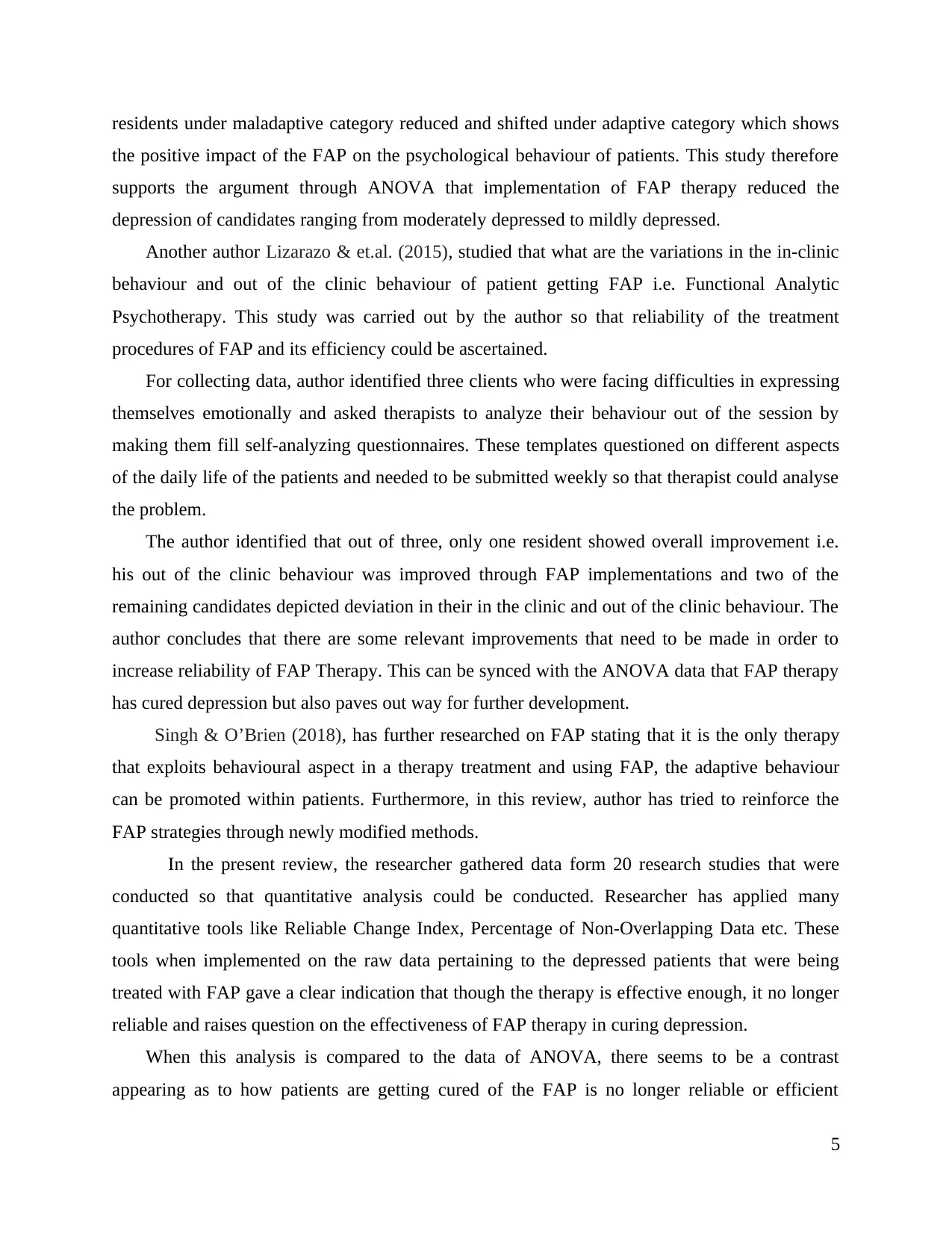
residents under maladaptive category reduced and shifted under adaptive category which shows
the positive impact of the FAP on the psychological behaviour of patients. This study therefore
supports the argument through ANOVA that implementation of FAP therapy reduced the
depression of candidates ranging from moderately depressed to mildly depressed.
Another author Lizarazo & et.al. (2015), studied that what are the variations in the in-clinic
behaviour and out of the clinic behaviour of patient getting FAP i.e. Functional Analytic
Psychotherapy. This study was carried out by the author so that reliability of the treatment
procedures of FAP and its efficiency could be ascertained.
For collecting data, author identified three clients who were facing difficulties in expressing
themselves emotionally and asked therapists to analyze their behaviour out of the session by
making them fill self-analyzing questionnaires. These templates questioned on different aspects
of the daily life of the patients and needed to be submitted weekly so that therapist could analyse
the problem.
The author identified that out of three, only one resident showed overall improvement i.e.
his out of the clinic behaviour was improved through FAP implementations and two of the
remaining candidates depicted deviation in their in the clinic and out of the clinic behaviour. The
author concludes that there are some relevant improvements that need to be made in order to
increase reliability of FAP Therapy. This can be synced with the ANOVA data that FAP therapy
has cured depression but also paves out way for further development.
Singh & O’Brien (2018), has further researched on FAP stating that it is the only therapy
that exploits behavioural aspect in a therapy treatment and using FAP, the adaptive behaviour
can be promoted within patients. Furthermore, in this review, author has tried to reinforce the
FAP strategies through newly modified methods.
In the present review, the researcher gathered data form 20 research studies that were
conducted so that quantitative analysis could be conducted. Researcher has applied many
quantitative tools like Reliable Change Index, Percentage of Non-Overlapping Data etc. These
tools when implemented on the raw data pertaining to the depressed patients that were being
treated with FAP gave a clear indication that though the therapy is effective enough, it no longer
reliable and raises question on the effectiveness of FAP therapy in curing depression.
When this analysis is compared to the data of ANOVA, there seems to be a contrast
appearing as to how patients are getting cured of the FAP is no longer reliable or efficient
5
the positive impact of the FAP on the psychological behaviour of patients. This study therefore
supports the argument through ANOVA that implementation of FAP therapy reduced the
depression of candidates ranging from moderately depressed to mildly depressed.
Another author Lizarazo & et.al. (2015), studied that what are the variations in the in-clinic
behaviour and out of the clinic behaviour of patient getting FAP i.e. Functional Analytic
Psychotherapy. This study was carried out by the author so that reliability of the treatment
procedures of FAP and its efficiency could be ascertained.
For collecting data, author identified three clients who were facing difficulties in expressing
themselves emotionally and asked therapists to analyze their behaviour out of the session by
making them fill self-analyzing questionnaires. These templates questioned on different aspects
of the daily life of the patients and needed to be submitted weekly so that therapist could analyse
the problem.
The author identified that out of three, only one resident showed overall improvement i.e.
his out of the clinic behaviour was improved through FAP implementations and two of the
remaining candidates depicted deviation in their in the clinic and out of the clinic behaviour. The
author concludes that there are some relevant improvements that need to be made in order to
increase reliability of FAP Therapy. This can be synced with the ANOVA data that FAP therapy
has cured depression but also paves out way for further development.
Singh & O’Brien (2018), has further researched on FAP stating that it is the only therapy
that exploits behavioural aspect in a therapy treatment and using FAP, the adaptive behaviour
can be promoted within patients. Furthermore, in this review, author has tried to reinforce the
FAP strategies through newly modified methods.
In the present review, the researcher gathered data form 20 research studies that were
conducted so that quantitative analysis could be conducted. Researcher has applied many
quantitative tools like Reliable Change Index, Percentage of Non-Overlapping Data etc. These
tools when implemented on the raw data pertaining to the depressed patients that were being
treated with FAP gave a clear indication that though the therapy is effective enough, it no longer
reliable and raises question on the effectiveness of FAP therapy in curing depression.
When this analysis is compared to the data of ANOVA, there seems to be a contrast
appearing as to how patients are getting cured of the FAP is no longer reliable or efficient
5
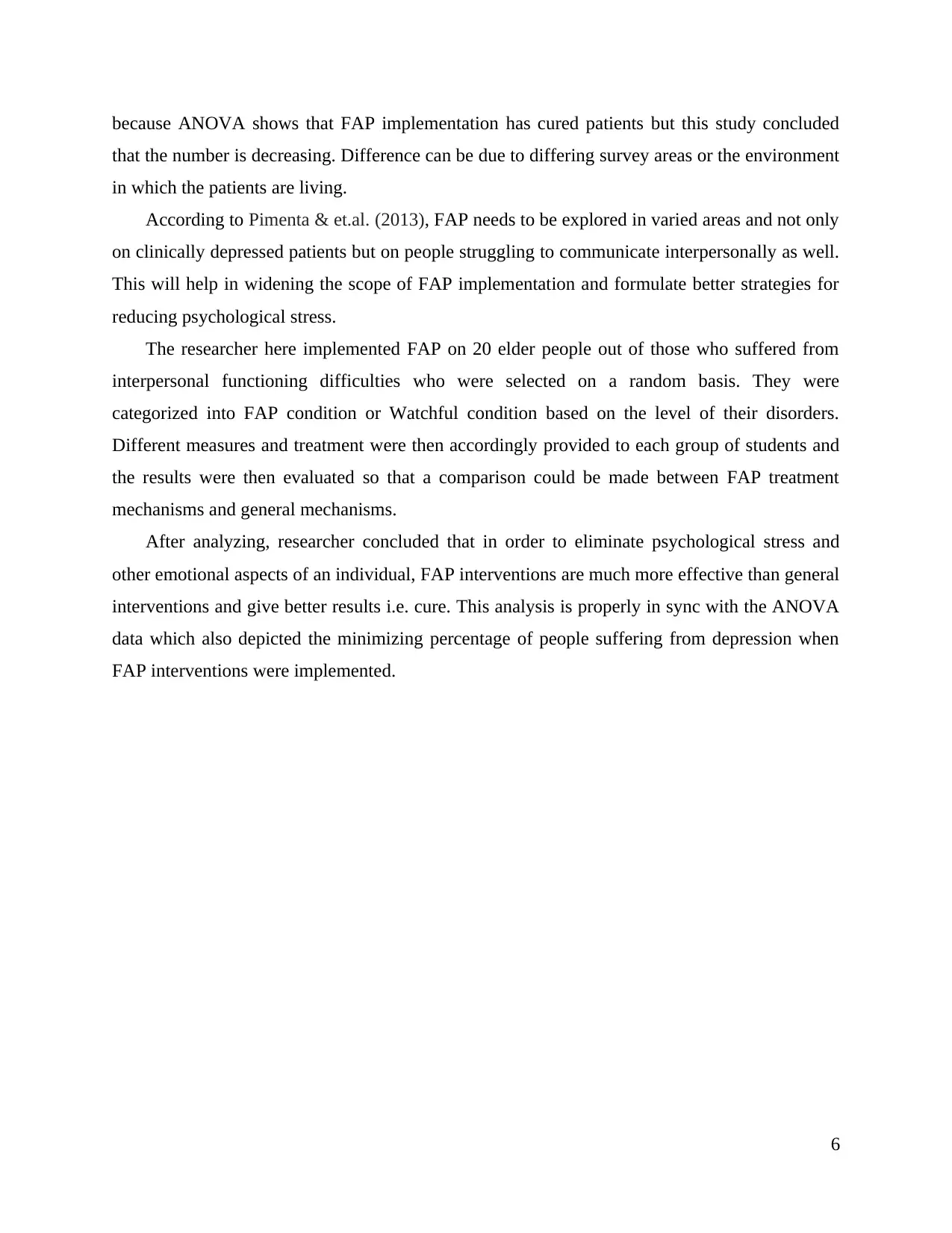
because ANOVA shows that FAP implementation has cured patients but this study concluded
that the number is decreasing. Difference can be due to differing survey areas or the environment
in which the patients are living.
According to Pimenta & et.al. (2013), FAP needs to be explored in varied areas and not only
on clinically depressed patients but on people struggling to communicate interpersonally as well.
This will help in widening the scope of FAP implementation and formulate better strategies for
reducing psychological stress.
The researcher here implemented FAP on 20 elder people out of those who suffered from
interpersonal functioning difficulties who were selected on a random basis. They were
categorized into FAP condition or Watchful condition based on the level of their disorders.
Different measures and treatment were then accordingly provided to each group of students and
the results were then evaluated so that a comparison could be made between FAP treatment
mechanisms and general mechanisms.
After analyzing, researcher concluded that in order to eliminate psychological stress and
other emotional aspects of an individual, FAP interventions are much more effective than general
interventions and give better results i.e. cure. This analysis is properly in sync with the ANOVA
data which also depicted the minimizing percentage of people suffering from depression when
FAP interventions were implemented.
6
that the number is decreasing. Difference can be due to differing survey areas or the environment
in which the patients are living.
According to Pimenta & et.al. (2013), FAP needs to be explored in varied areas and not only
on clinically depressed patients but on people struggling to communicate interpersonally as well.
This will help in widening the scope of FAP implementation and formulate better strategies for
reducing psychological stress.
The researcher here implemented FAP on 20 elder people out of those who suffered from
interpersonal functioning difficulties who were selected on a random basis. They were
categorized into FAP condition or Watchful condition based on the level of their disorders.
Different measures and treatment were then accordingly provided to each group of students and
the results were then evaluated so that a comparison could be made between FAP treatment
mechanisms and general mechanisms.
After analyzing, researcher concluded that in order to eliminate psychological stress and
other emotional aspects of an individual, FAP interventions are much more effective than general
interventions and give better results i.e. cure. This analysis is properly in sync with the ANOVA
data which also depicted the minimizing percentage of people suffering from depression when
FAP interventions were implemented.
6
⊘ This is a preview!⊘
Do you want full access?
Subscribe today to unlock all pages.

Trusted by 1+ million students worldwide
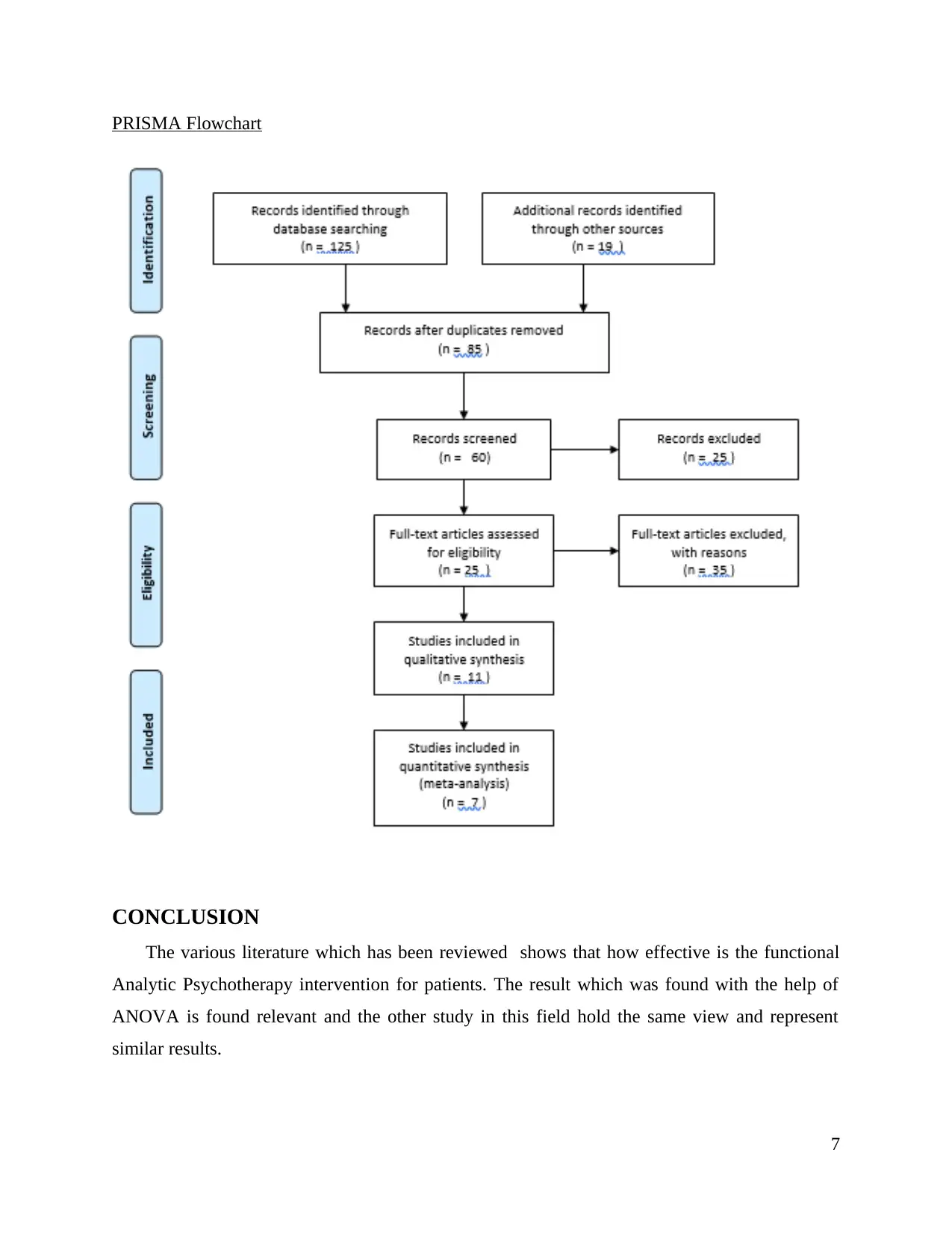
PRISMA Flowchart
CONCLUSION
The various literature which has been reviewed shows that how effective is the functional
Analytic Psychotherapy intervention for patients. The result which was found with the help of
ANOVA is found relevant and the other study in this field hold the same view and represent
similar results.
7
CONCLUSION
The various literature which has been reviewed shows that how effective is the functional
Analytic Psychotherapy intervention for patients. The result which was found with the help of
ANOVA is found relevant and the other study in this field hold the same view and represent
similar results.
7
Paraphrase This Document
Need a fresh take? Get an instant paraphrase of this document with our AI Paraphraser
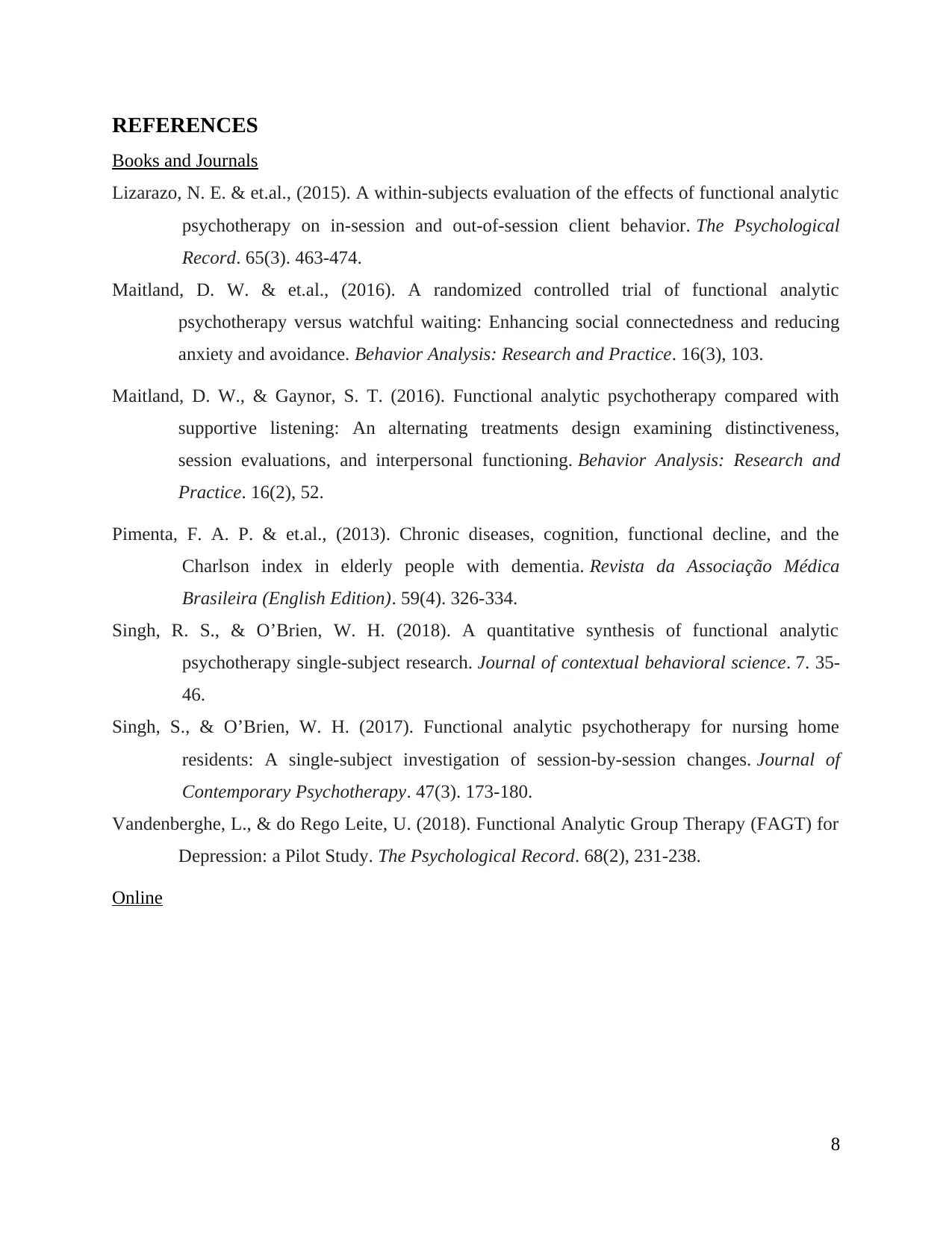
REFERENCES
Books and Journals
Lizarazo, N. E. & et.al., (2015). A within-subjects evaluation of the effects of functional analytic
psychotherapy on in-session and out-of-session client behavior. The Psychological
Record. 65(3). 463-474.
Maitland, D. W. & et.al., (2016). A randomized controlled trial of functional analytic
psychotherapy versus watchful waiting: Enhancing social connectedness and reducing
anxiety and avoidance. Behavior Analysis: Research and Practice. 16(3), 103.
Maitland, D. W., & Gaynor, S. T. (2016). Functional analytic psychotherapy compared with
supportive listening: An alternating treatments design examining distinctiveness,
session evaluations, and interpersonal functioning. Behavior Analysis: Research and
Practice. 16(2), 52.
Pimenta, F. A. P. & et.al., (2013). Chronic diseases, cognition, functional decline, and the
Charlson index in elderly people with dementia. Revista da Associação Médica
Brasileira (English Edition). 59(4). 326-334.
Singh, R. S., & O’Brien, W. H. (2018). A quantitative synthesis of functional analytic
psychotherapy single-subject research. Journal of contextual behavioral science. 7. 35-
46.
Singh, S., & O’Brien, W. H. (2017). Functional analytic psychotherapy for nursing home
residents: A single-subject investigation of session-by-session changes. Journal of
Contemporary Psychotherapy. 47(3). 173-180.
Vandenberghe, L., & do Rego Leite, U. (2018). Functional Analytic Group Therapy (FAGT) for
Depression: a Pilot Study. The Psychological Record. 68(2), 231-238.
Online
8
Books and Journals
Lizarazo, N. E. & et.al., (2015). A within-subjects evaluation of the effects of functional analytic
psychotherapy on in-session and out-of-session client behavior. The Psychological
Record. 65(3). 463-474.
Maitland, D. W. & et.al., (2016). A randomized controlled trial of functional analytic
psychotherapy versus watchful waiting: Enhancing social connectedness and reducing
anxiety and avoidance. Behavior Analysis: Research and Practice. 16(3), 103.
Maitland, D. W., & Gaynor, S. T. (2016). Functional analytic psychotherapy compared with
supportive listening: An alternating treatments design examining distinctiveness,
session evaluations, and interpersonal functioning. Behavior Analysis: Research and
Practice. 16(2), 52.
Pimenta, F. A. P. & et.al., (2013). Chronic diseases, cognition, functional decline, and the
Charlson index in elderly people with dementia. Revista da Associação Médica
Brasileira (English Edition). 59(4). 326-334.
Singh, R. S., & O’Brien, W. H. (2018). A quantitative synthesis of functional analytic
psychotherapy single-subject research. Journal of contextual behavioral science. 7. 35-
46.
Singh, S., & O’Brien, W. H. (2017). Functional analytic psychotherapy for nursing home
residents: A single-subject investigation of session-by-session changes. Journal of
Contemporary Psychotherapy. 47(3). 173-180.
Vandenberghe, L., & do Rego Leite, U. (2018). Functional Analytic Group Therapy (FAGT) for
Depression: a Pilot Study. The Psychological Record. 68(2), 231-238.
Online
8

9
⊘ This is a preview!⊘
Do you want full access?
Subscribe today to unlock all pages.

Trusted by 1+ million students worldwide

10
Paraphrase This Document
Need a fresh take? Get an instant paraphrase of this document with our AI Paraphraser

11
1 out of 11
Related Documents
Your All-in-One AI-Powered Toolkit for Academic Success.
+13062052269
info@desklib.com
Available 24*7 on WhatsApp / Email
![[object Object]](/_next/static/media/star-bottom.7253800d.svg)
Unlock your academic potential
Copyright © 2020–2025 A2Z Services. All Rights Reserved. Developed and managed by ZUCOL.





